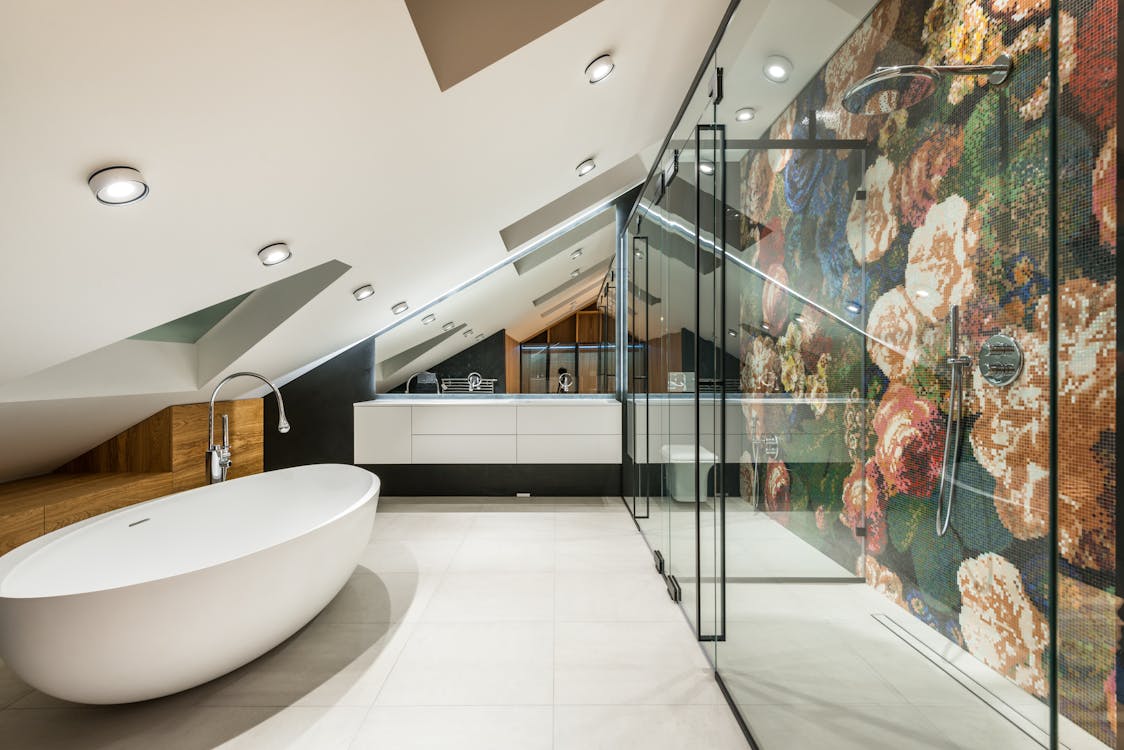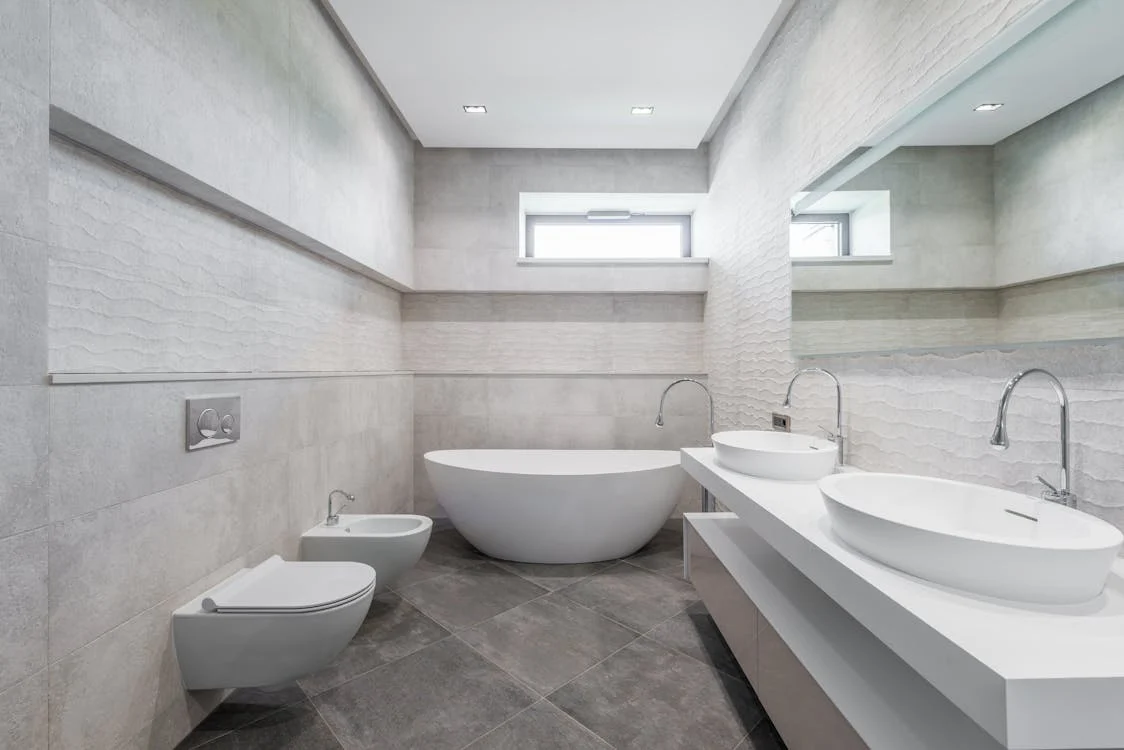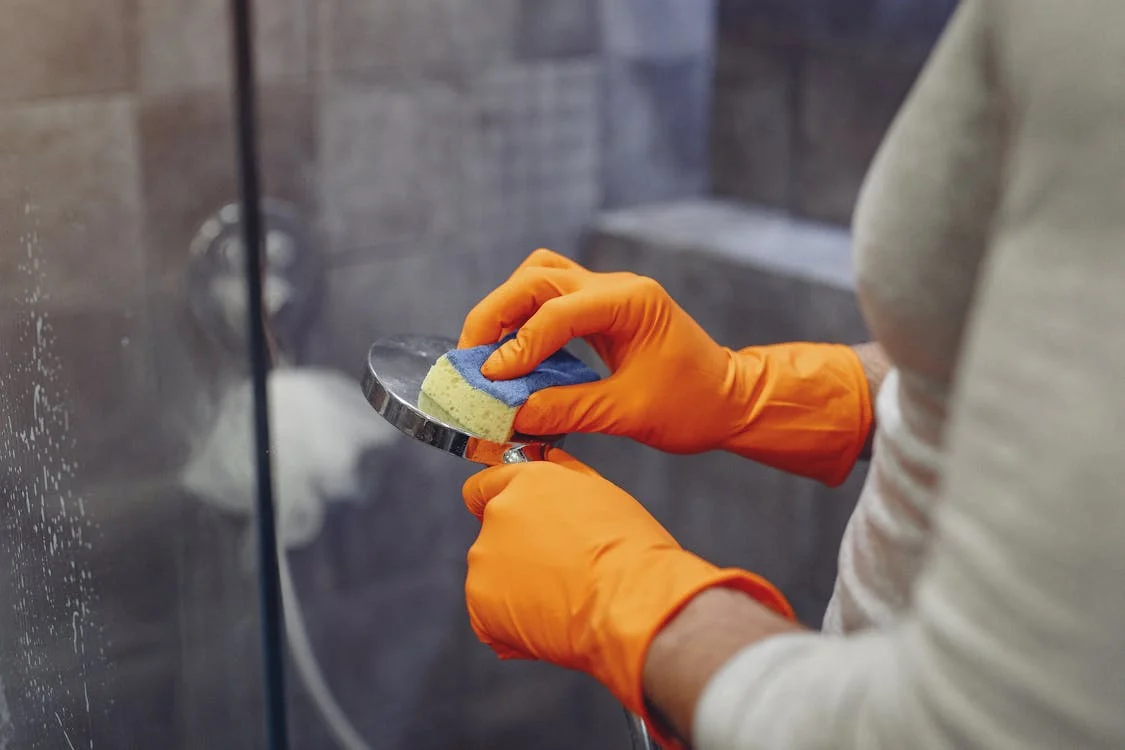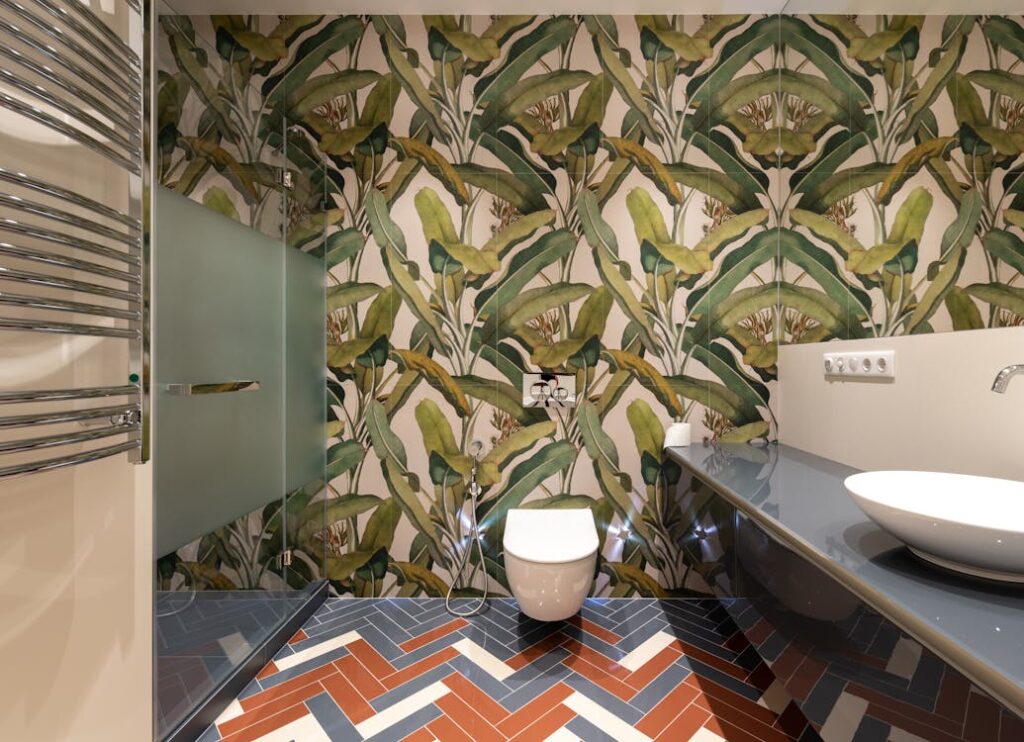Walk-in showers have become a staple in modern home design, celebrated for their sleek appearance and ease of use. Unlike traditional shower-tub combos, walk-in showers are designed with accessibility and open space in mind.
They typically feature minimalistic lines with glass enclosures that contribute to a feeling of spaciousness, even in smaller bathrooms. As homeowners look for bathroom upgrades that enhance both value and functionality, walk-in showers are increasingly preferred over regular showers and bathtubs for their aesthetic flexibility and improved accessibility.
Curious about what makes up these popular fixtures? Read on to discover the various materials used in walk-in showers and how they can transform your bathroom experience.
Materials Used in Walk-In Showers
Walk-in showers offer not just functionality but also a canvas for aesthetic expression. The materials used in their construction are key to both their design and longevity. Here, we explore some of the most popular materials that bring these elegant features to life, focusing on their benefits, style contributions, and practical advantages in a modern home.
Glass Enclosures: Elegance and Openness

Glass enclosures are synonymous with modern walk-in showers. They provide a sleek, uninterrupted look that enhances the feeling of space.
Glass walls and doors allow natural light to permeate the bathroom, creating a more open and airy environment. They also offer seamless transitions between the shower area and the rest of the bathroom, making the space appear larger.
Safety is paramount in shower design, so tempered glass is used due to its strength and break-safety features. Frosted and textured glass options are available, too, providing privacy while still letting light flow freely.
Ceramic and Porcelain Tile: Durable and Stylish

Ceramic and porcelain tiles are the cornerstones of shower design, known for their durability and wide range of styles.
While both materials are made from clay, porcelain tiles are fired at higher temperatures, making them denser and more resistant to moisture and frost. Ceramic tiles, however, offer a wider variety of designs and are generally less expensive.
Due to their versatility in walk-in shower color, size, and pattern, these tiles can easily match any bathroom style, from classic to contemporary. They significantly influence the bathroom’s aesthetic and can define the character of the shower space.
Natural Stone: Luxurious and Unique

Natural stone in walk-in showers exudes luxury and uniqueness, each piece bringing its history and beauty.
Popular choices include slate, marble, granite, and limestone. Each offers distinct textures and colors. Stone tiles provide a high-end, natural look that can dramatically increase the value of a home. They are also durable and maintain their quality with proper care, making them a smart investment for homeowners.
Composite Materials: Modern and Versatile

Composites such as acrylic and fiberglass are favored in walk-in shower designs for their adaptability and cost-effectiveness.
These materials are engineered to resist moisture and mildew, making them ideal for busy, modern bathrooms. Acrylic and fiberglass are excellent for those looking to remodel their bathrooms on a budget. They offer a clean, attractive look that mimics more expensive materials but at a fraction of the cost.
By selecting the right materials, homeowners can ensure that their walk-in shower is not only a functional space but also a highlight of home improvement and style.
Design Elements of Walk-In Showers
When designing a walk-in shower, every element plays a critical role in both functionality and aesthetic appeal. From the flooring that ensures safety to the choice between a shower door or an open design, each component contributes to the overall experience.
Let’s delve into the key design elements that define today’s walk-in showers, enhancing comfort, safety, and style.
Shower Floors: Safety and Style
The shower floor is fundamental not just for the shower’s function but also for the safety of its users.
- Importance of Slip-resistant Materials: Materials such as textured ceramic tiles, stone, and slip-resistant vinyl are essential to prevent accidents. These materials provide grip underfoot, which is crucial in a wet environment.
- Discussion of Sloped Floors for Drainage: Proper drainage is critical in walk-in showers to avoid water accumulation and the problems it brings, such as mildew growth. A gently sloped floor efficiently directs water toward the drain, enhancing the shower’s cleanliness and maintenance.
Seating Options: Comfort and Accessibility
Incorporating seating into walk-in showers marries comfort with accessibility, making these spaces more versatile and user-friendly.
- Benefits of Built-in Seats and Benches: Seats are not just a luxury; they make showers more accessible to those with mobility issues and provide a place to relax. They are especially useful in multi-generational homes.
- Materials Used for Seating Areas: Stone, teak, and waterproof composites are commonly used for seating because they can withstand constant exposure to water and humidity while still providing comfort and support.
Shower Doors vs. Open Designs
Choosing between a shower door and an open design can affect the look and functionality of a bathroom.
- Pros and Cons of Having a Door: Doors, such as sliding or hinged glass doors, can prevent water splashes and keep heat inside the shower. However, they require space to operate and can necessitate regular cleaning to avoid soap scum and water spots.
- Materials Used for Doors, Including Frameless Options: Frameless glass doors offer a sleek, modern look that can make the bathroom appear bigger and more open. They are made from tempered glass for safety and are easier to clean due to the lack of frames where grime can accumulate.
Enhancing Light and Space

Maximizing light and the sense of space can transform the feel of a bathroom, making it more pleasant and inviting.
Using materials like clear glass for enclosures allows natural light to spread throughout the bathroom, which can make the room feel more open and airy.
Mirrors strategically placed can visually double the space in a small bathroom, while light-colored tiles can make the space feel less cramped. Additionally, a seamless transition from the bathroom floor to the shower floor can create an unbroken line of sight, further enhancing the perception of space.
These design elements are not just about style; they also ensure that a walk-in shower is safe, comfortable, and a fitting addition to any modern home. By choosing the right materials and designs, homeowners can create a bathroom that is not only functional but also a personal retreat.
Special Features and Additions
Modern walk-in showers go beyond simple aesthetics and functionality; they are about creating a personalized and luxurious bathing experience. From custom designs tailored to individual preferences to advanced features that turn a shower into a spa-like retreat, these enhancements make a significant impact on the utility and enjoyment of the bathroom.
Customization Options
Customizing a walk-in shower allows for a tailored bathing experience that perfectly complements a bathroom’s unique layout and style.
- Tailoring Materials for a Custom Walk-In Shower: Homeowners can choose from a variety of materials such as glass, ceramic, porcelain, or natural stone to create a look that complements their bathroom decor. Options like adjustable shower heads, built-in benches, or custom niches for toiletries add functional touches that cater to personal preferences.
- How Customization Affects the Cost: While customization provides a personal touch, it can significantly impact the overall cost. The choice of materials, the complexity of the design, and any specialized features can drive up the expenses. However, custom features often increase the value of the home, making them a worthwhile investment for many.
Advanced Features: Multiple Nozzles and Steam Functions
Incorporating advanced features can transform a walk-in shower into a daily luxury.
- Discussion on the Inclusion of Luxury Features: Features like multiple nozzles and steam functions can elevate a simple shower to a therapeutic experience, offering everything from a gentle mist to a full-body massage. These features cater to different needs and preferences, enhancing the shower’s functionality.
- Materials that Support Advanced Technology: Integrating advanced features requires the use of specialized materials and technology. For instance, digital controls for steam and temperature adjustments need proper insulation and waterproofing. High-quality materials like stainless steel for nozzles and non-porous tiles for steam retention are crucial to supporting these technologies.
Walk-in Shower Accessibility Features
Enhancing accessibility in walk-in showers makes them a viable option for everyone, regardless of mobility.
- Materials Used to Enhance Safety for Users with Mobility Issues: Non-slip tiles, grab bars, and low-threshold entries are essential for making showers accessible. Materials need to be durable yet gentle enough to prevent injuries in case of falls.
- Importance of Barrier-Free Access: A barrier-free or zero-entry shower is crucial for individuals using wheelchairs or those who find it difficult to step over a traditional shower’s lip. These designs not only promote independence but also enhance the safety of the shower, ensuring it is a comfortable space for all family members.
By integrating these special features and additions, a walk-in shower can cater to the diverse needs of a household, combining luxury with practicality in a cohesive and inviting bathroom environment.
How Different Materials Affect the Cleaning Process

Maintaining the pristine condition of walk-in showers involves understanding how different materials react to water, soap, and cleaning agents. Each material, from tiles to glass, has specific care requirements that can significantly influence the routine and methods of cleaning. Whether you’re dealing with a glass-enclosed shower or a ceramic-tiled space, knowing how to maintain each type of walk-in shower can help keep your shower looking new.
Tips to Prevent Soap Scum and Mildew Growth
Maintaining a clean and hygienic walk-in shower requires regular attention, especially to combat common issues like soap scum and mildew. Here are some material-specific tips:
1. Ceramic Tile:
Ceramic tiles are favored for many walk-in showers due to their ease of cleaning. The glazed finish on ceramic tiles acts as a protective barrier against stains and scum, making them an excellent choice for busy bathrooms.
Use a mild detergent and a soft brush for regular cleaning to prevent soap scum buildup. Vinegar is effective and safe for removing hard water stains on ceramic surfaces.
When installing ceramic tiles, ensuring professional installation and proper grout lines can enhance their longevity and appearance. Use cement board underneath as a reliable moisture barrier.
2. Porcelain Tile:
Porcelain tiles share many of the pros of ceramic but are known for their density and low porosity, making them ideal for both floor space and wall applications in showers.
Routine cleaning with a mixture of vinegar and water is sufficient for porcelain tiles. However, to avoid damaging the glaze, a pH-neutral cleaner is recommended for more thorough cleaning.
Porcelain’s durability makes it a budget-friendly option in the long run. Its moisture resistance reduces the risk of mildew growth.
3. Stone Tile:
Stone tiles, such as marble or slate, bring natural beauty to enclosed showers but require more meticulous care due to their porosity.
Use cleaners specifically designed for natural stone. Avoid acidic substances which can etch the surface. It’s also crucial to seal stone tiles periodically to maintain their moisture resistance.
Stone tiles can be used to create a custom walk-in shower with a built-in bench or seat, adding both style and functionality.
4. Glass Enclosures:
Glass enclosures are popular in many walk-in showers because they create a feeling of openness and space. They can be fully or partially enclosed and often come with features like built-in benches for better accessibility.
Daily use of a squeegee will prevent water spots and soap scum buildup. A diluted vinegar solution can be used for regular cleaning to maintain clarity and prevent mildew.
Consider frameless glass doors for a seamless transition that makes a small bathroom feel less cramped while enhancing natural light.
General Cleaning Tips
Regardless of the material, some general practices can help maintain any walk-in shower:
- Dry Surfaces: After each use, dry the walls and floor to reduce mildew growth.
- Ventilation: Install an efficient ventilation system to help manage moisture levels in the bathroom, which supports a cleaner and fresher environment.
- Steam Cleaning: For a deep clean that avoids harsh chemicals, a steam cleaner can be effective across various materials, including grout lines.
By choosing the right materials and adopting appropriate cleaning strategies, you can ensure your walk-in shower remains a clean, inviting space without excessive maintenance. Regular care not only extends the life of the materials but also enhances your overall showering experience, making it a popular project in home improvement.
Final Thoughts on Enhancing Your Bathroom

The materials you choose for your walk-in shower not only determine its look and feel but also its functionality and maintenance level. The right materials can transform a simple bathroom into a luxurious retreat, enhancing both the usability and aesthetics of your space.
Whether it’s the elegance of glass, the versatility of tiles, the luxury of natural stone, or the practicality of composites, each material brings its own set of benefits that can significantly elevate the quality of your bathroom renovation project. Experience Spa-Like Bath and Shower with the right choice.
Choosing wisely, with an eye for both style and function, ensures a walk-in shower that you will enjoy for years to come.
